Insect & Disease Conditions Update
The week of May 17-23 is quite a busy one in the world of forest health as it is Emerald Ash Borer Awareness Week, Arbor Week and last but not least National Invasive Species Awareness Week (NISAW). We urge you to check out the various web based materials and events that are available through MFS as well as other agencies and departments. This week is meant to raise awareness to forest health issues regarding invasive species but also to celebrate healthy forests and ecosystems, every small act helps; from planting a tree to helping remove invasive species in your own yard.
As the 2020 growing season begins, we know our readers are busy outside among the trees, observing the welcome signs of spring’s transition into summer. At this time, it seems appropriate to remind people of a few tree health tips for early summer. As the dormant season for trees is over, and all pruning of living wood has ceased (you can prune dead wood at any time of the year), remember that spring cleaning around trees is equally as important as a fall cleaning to remove leaves, pruned material and other tree and shrub debris that may harbor overwintered insects or diseases. Disposing of the material by bagging and landfilling or burning it (only when and where permitted) is a good idea to prevent organisms harmful to tree health from becoming an issue later on. Now is also the time to sharpen your observation skills, noticing the beauty of the forest and trees, but also what may not be normal or signs of tree health threats or decline. As always, you can reach us with concerns or observations about forest health at: https://appengine.egov.com/apps/me/dacf/mfs-tree-ailment, or (207) 287-2431.
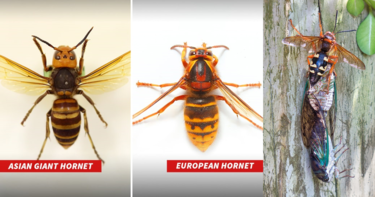
Asian Giant Hornet (Vespa mandarinia) – Nothing sells news more than an exaggerated, scary story and that is certainly the case when it comes to “murder hornets.” These “murder hornets” are not invading the U.S., and the people that should be aware of these hornets are residents in Washington state and southern British Columbia to make sure it doesn’t get established. The murder aspect of the hornet refers to the way it goes after European honeybee larvae, which also happen to be non-native. Like all hornets and social wasps the Asian giant hornets have no interest in humans unless you are disturbing their nest/larvae. We can assure you that there is nothing to worry about as far as Asian giant hornets are concerned. With warmer weather comes increased insect activity and there are a couple of large wasps that are found in Maine that may be confused for the Asian giant hornet.
A related wasp in the same genus is the European Hornet (Vespa crabro) which has been established in the U.S. since the 1800’s. European hornets are very large wasps that look very similar to Asian giant hornets. They typically nest in dark cavities, usually hollow logs deep in the woods. People usually come into contact with this species in the spring when new queens are beginning to make nests or in the fall as workers change from capturing other insects to a scavenging lifestyle.
The other look-alike is the aptly named eastern cicada killer (Sphecius speciosus), which is one of our largest native wasps. These large non-aggressive wasps build nests in the soil, often in lawns, and are commonly encountered during the summer months. The females provision their nest with a cicada they capture and paralyze, in which they lay an egg and bury. The males can be territorial and may fly in a seemingly aggressive manner ‘buzzing’ intruders, but due to a lack of a stinger, they are incapable of stinging. Images: (left and middle) Side-by-side comparison of Asian giant hornet and the closely related European hornet. Getty; (right) Female cicada killer and prey. S. Larcolt.
|
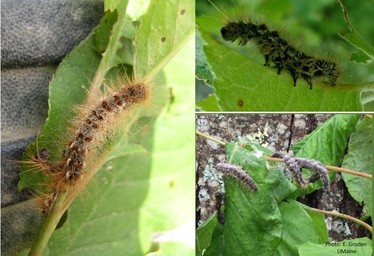
Browntail Moth (Euproctis chrysorrhoea) – Although most of the world is still in quarantine, browntail moth caterpillars have ended their self-imposed winter quarantine and will be found basking on the outside of their winter webs and feeding on newly emerging leaves. This year we will be monitoring weekly caterpillar development and monitoring for outbreaks of the fungus that attacks BTM, called Entomophaga aulicae. The Maine Forest Service would like your help in reporting cases of diseased caterpillars so we can track the progression of the outbreak. Infected caterpillars will have a puffy, swollen appearance and are covered in whitish/yellowish dust, which are spores of the fungi. As caterpillars succumb to the fungus, they will hold tight to the branches they die on which helps the spread of the browntail caterpillar-killing spores. Reports of diseased caterpillars can be made at https://www.surveymonkey.com/r/9VKYFLV.
The new risk map for 2020 is along with winter web survey data can be found on the MFS website, follow the link for browntail moth from www.maineforestservice.org. Web abundance increased in Waldo, Knox and Hancock counties. Fewer webs than in previous years were observed heading south along the coast, but populations in many of those areas are still heavy enough to cause impacts to people. MFS and Maine CDC will again be collaborate with 211 to answer the call volume associated with BTM. Be sure to check out the FAQ page which has a lot of great information on this itchy tree- and human health pest. Images: Dead Browntail moth caterpillars infected with E. aulicae; Browntail moth risk map 2020. MFS
|
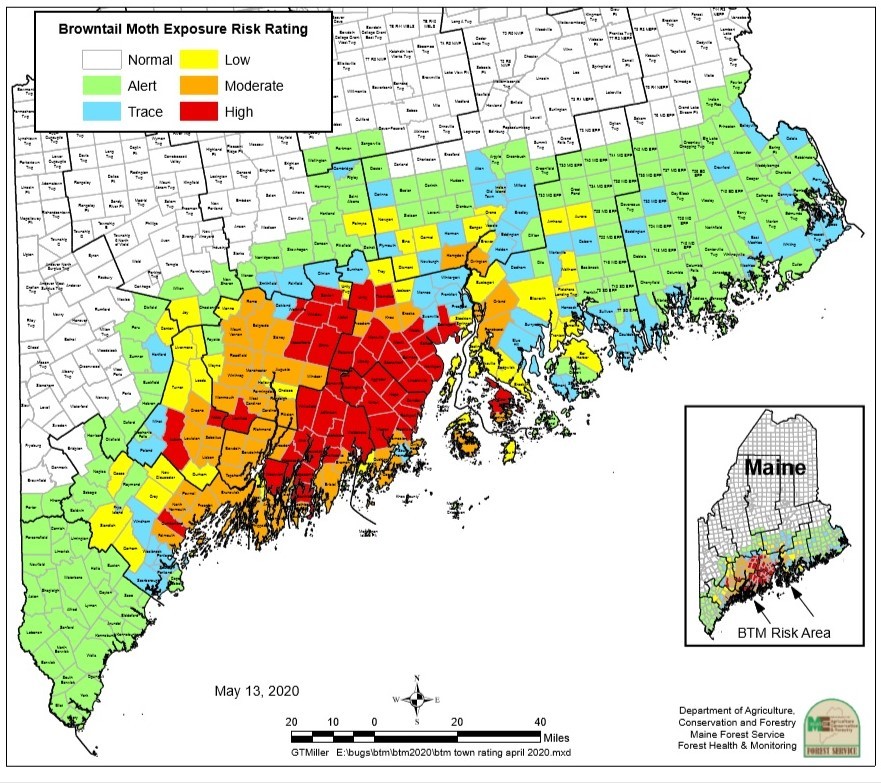
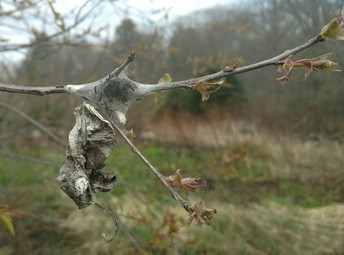
Eastern Tent Caterpillar vs Browntail Moth (Malacosoma americanum; Euproctis chrysorrhoea) – It’s a case of mistaken identity. Every season we receive calls from concerned citizens who mistake eastern tent caterpillar nests for browntail nests. Two key differences between the typical nests these species make are size and position on the tree.
The silken nests of native eastern tent caterpillars start small but can grow quite large, reaching around the size of a football and are attached to the tree where the branches meet the trunk. Eastern tent caterpillars lack the two orange spots on the tail end of the caterpillar.
Browntail winter webs are the size of your palm or smaller and are constructed in late summer/early fall on the tips of the branches and are comprised of silk that also incorporates the leaves on the branch tips. As the caterpillars become active in the spring, they travel in and out of the web, and the web can become surrounded in gauzy silk similar in texture to that made by eastern tent caterpillar. Browntail moth caterpillars are dark brown and have two orange spots towards the rear of their bodies. As the caterpillars molt, they develop white stripes due to white tufts of hair on each segment.
The photo shows an eastern tent caterpillar nest (upper) next to a browntail moth winter web (lower) (note, the eastern tent caterpillar nest is less dense and will continue to enlarge as it develops through the spring and summer). Image: BTM winter web next to Eastern tent caterpillar web. MFS
|
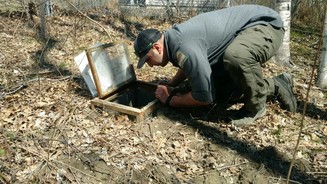
Winter moth (Operophtera brumata) – Last September an emergence cage was set out in Boothbay Harbor that contained 500 cocoons of the biocontrol for winter moth, Cyzenis albicans. Boothbay Harbor was selected as the release site for this very important fly due to the high population of winter moth which caused a great deal of defoliation there in the spring of 2019. On April 29, we released the Cyzenis flies from their holding cage. This year we had great fly emergence and counted over 100 that came out early; the rest of the flies will emerge throughout May. After mating, the flies will feed on nectar from spring flowers, including maple trees. After the females fully mature, they will seek out leaves damaged by winter moth caterpillars and lay their eggs, which will then be ingested by the caterpillars. The fly eggs will hatch inside the wintermoth larvae, leading to mortality. Image: Forest entomologist Mike Parisio counts emerging Cyzenis albicans. MFS
|
Emerald Ash Borer (EAB) (Agrilus planipennis) – Despite what appears to be a delayed spring, the emerald ash borer (EAB) regulatory flight period began on May 1. This is a reminder that it is now possible for adult EAB to be emerging from ash trees in Maine, and that additional precautions should be taken even when moving regulated materials even within the EAB quarantine zone. Known infested materials should be kept on site whenever possible. If they must be moved, measures should be taken to reduce the chance they’ll spread the insect further. If you have any doubts whatsoever, please contact the MFS Insect & Disease lab. To help make informed decisions about moving ash materials, MFS has prepared these simple best management practices.
Also in EAB regulatory news, formal revisions to Maine’s EAB quarantine area were made in March of 2020. The northern unit of the quarantine area remains unchanged; however, the southern unit has been expanded to now include all of York and Cumberland counties, as well as the five southernmost towns in Oxford Co. For those who have not had a chance to view the updated map yet, it can be found here.
Finally, whenever camping season does arrive this year, here is a friendly reminder that all out-of-state firewood is banned. Importation of firewood is only permitted if it is certified heat treatment. Seasoning and kiln-drying do not qualify as certified methods. For more information, please review our Maine firewood FAQs.
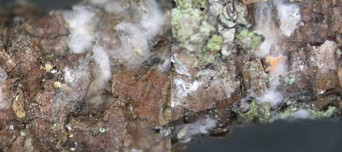
Red Pine Scale (Matsucoccus matsumarae) - Since first detected in Maine on Mount Desert Island in 2014, red pine scale continues to spread slowly but surely. The last time we reported on red pine scale was in our October 2019 conditions report following a new detection in Kittery, ME. Since then, new locations with red pine scale populations have been identified both on Hancock Point and in Gouldsboro, in addition to being highly-suspected on the nearby Sorrento peninsula.
Our current knowledge of the whereabouts of red pine scale in Maine remains limited, but what we do know so far supports wind driven dispersal in a favorable coastal microclimate. Our ability to detect this pest efficiently remains hampered by its cryptic nature and masking of symptoms by other prevalent red pine issues, primarily shoot blights that cause similar discoloration of foliage. We will continue to survey for red pine scale simultaneously in conjunction with current red pine pathogen monitoring activities, in addition to survey work around the core known areas and further down east into Washington Co.
This insect is incredibly hard to see and usually cannot be confirmed without the aid of a microscope. However, in a time where we’re all doing more yard work than we’d usually have time for, you might be lucky enough to glimpse the white wool-like covering produced by the insect on the twigs of red pines. If you do happen to see anything resembling the photo below while pruning or raking this spring, please contact the MFS Insect & Disease lab. Image: Small amounts of white flocculation produced on the twigs of red pines harboring red pine scale populations. Karen Coluzzi, Maine DACF.
|
Spruce Budworm (Choristoneura fumiferana) – The annual “Spruce Budworm in Maine” report, 2019 edition, was released in early April of 2020 and can be viewed online here.
As reported in the January conditions report, this past season was one of increased activity for spruce budworm, with average pheromone trap catches up statewide from 20 per trap in 2018 to 67 in 2019.
2020 could prove to be an interesting year, as fallout from COVID-19 will possibly present challenges for monitoring activities in Maine and sample processing in Canada, while at the same time SBW populations appear to be climbing again. We will continue our SBW monitoring activities to the best of our abilities during this important pre-outbreak period, at whatever capacity that may be. As always, we thank our dedicated network of cooperators in advance for their willingness to participate in the 2020 trapping season and for their understanding if adjustments to the scale of the program become unavoidable.
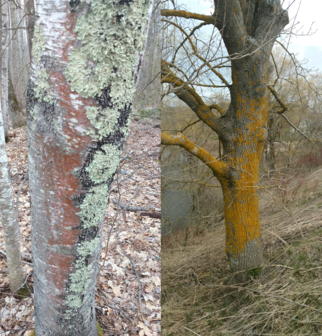
Algae and lichen growing on trees – Trees provide a habitat for a variety or organisms, including lichens and even algae. The insect and disease lab received several requests for assistance in past months directed at the organisms pictured here: The reddish filamentous algae, Trentepohlia spp., and the sunburst lichen, Xanthoria elegans. Although these brightly colored colonizers of trees look alarming, neither of these organisms pose a health risk to trees. In fact, lichens are very sensitive to air pollution and their presence indicates good air quality. Image: Trentepohlia spp. exist on many tree species but are often noticed on trees with lighter colored bark, like this birch also hosting a few species of lichen; a tree heavily colonized with sunburst lichen in Thomaston Maine. MFS
|
Foam at the base of trees during rains – During a period of heavy rain in spring 2020, a report was received about bubbles accumulating at the base of trees by one of our foresters via the public. This phenomenon can happen during heavier rains, particularly on trees that produce pitch – although this is also seen on other tree species. Essentially, trees produce secondary chemicals, mostly as bi-products of photosynthesis, for chemical defense against insects and pathogens (pine pitch being the best example). These substances can be exuded from plant parts, like leaves and bark. Various other substances also may accumulate on the bark of trees. When water runs down a trunk during a rainstorm it interacts with these various substances, changing the surface tension of the water. The result is a weak, almost soap-like solution. As the solution runs down the tree air is introduced to it via turbulent flow over the bark surface and bubbles form and accumulate at the base of the tree. This may occur more commonly during heavy rains after longer periods of dry weather. If under other conditions you notice foam exuding from a tree’s main stem or branches, this could be cause for concern. Slime flux/alcoholic flux, most often seen with elms, willows and sometimes oaks and maples, is an indication of internal decay. Unlike the bubbles described earlier, the froth of slime flux/alcoholic flux has yeasty, alcohol-like odor or other unpleasant smell.

Red Pine Survey Preliminary Results – In response to questions by industry and the general public about the health of red pine, a survey of planted red pine stands was initiated in 2019, with 22 sites and roughly 550 trees evaluated. Diplodia tip blight was recorded at all but one site, while Sirococcus shoot blight was present at 7 of 22 sites. Each time Sirococcus was found on site, Diplodia was also found and together they represented serious negative impacts to stand health. Heavy infection levels were observed in red pine plantings in Androscoggin, Aroostook, Cumberland, Kennebec, Lincoln, Oxford, Penobscot, Sagadahoc, Somerset, and York counties. The survey is planned to continue in 2020 to better understand the distribution and severity of disease impacting red pine resources. Image: Small and thin red pine crowns in a dieases-impacted stand viewed from the ground. MFS.
|
White Pine Needle Diseases – Data from the 2018 USFS-funded multi-state evaluation and monitoring project, ‘Monitoring eastern white pine decline and its causes in New England and New York through enhanced survey methods’ was analyzed in early 2020. The overall regional effort included 122 sites (488 plots) and 4,419 trees. Results for the 43 sites in Maine (172 plots, over 700 trees) showed at least 1 WPND disease agent was collected at all but two sites (Figure 3). Mycosphaerella dearnessii (Lecanosticta acicola, brown spot needle blight) was by far the most commonly encountered disease and was found at 24 sites; Septorioides strobi was found at 6 sites; Bifusella linearis was found at 8 sites; Lophophacidium dooksii (Dooks needle blight) was found at 6 sites; Lophodermium spp. was found at 2 sites (due to the low number of reports of this pathogen, it is not considered as a component of the WPND complex) (Figure 3). *This is a report of the full dataset and reflects different numbers that those reported earlier and in the June 2019 Conditions Report.
The other data collected for the study and analyzed by the USFS revealed the following basic findings: Stand basal area is negatively correlated with WPND severity and number of seedlings suggesting that managing toward lower stand density would increase resilience to foliar diseases. Also, presence of causal agents of WPND was correlated with a decrease in crown density.
The white pine needle diseases (WPND) complex that has been impacting white pine trees for more than 12 years is expected to continue in spring 2020 across Maine’s white pine resource due to the abnormally wet weather in spring 2019. This is due to the life cycles of the causal fungi, that release spores infecting newly emerging needles in spring. These infected needles show no symptoms until the following spring/early summer when they turn yellow, and are prematurely dropped, but not before producing spores during prolonged wet periods and infecting the new growth to perpetuate the disease cycle. Image: White pine needle disease distribution map based on 2018 survey plot locations. MFS.

April 27–June 1, Mondays at 11:00am (excluding May 25): Maine Forest Service Forest Health & Monitoring Division, Forest Health Webinar Series. This is a webinar series held on the Microsoft Teams platform covering current forest health issues is Maine. If you are not able to view the webinar at the scheduled time, all webinars will be made available at the following links:
May17-23: Emerald Ash Borer Awareness Week.
May 17-23: Invasive Species Awareness Week II.
May 17-23: Maine Arbor Week.
Office hours: The office is currently closed to the public, voice and emails are being monitored remotely and mail is being received. Updates to building access will be posted at www.maine.gov/dacf
NOTE: The Augusta office is now housed in the Deering Building, 90 Blossom Lane, Suite 201. The mailing address and phone numbers are unchanged. A map is available on our website. The lab at 50 Hospital Street is currently housing the Kennebec County Soil and Water Conservation District.
Conditions Report No. 2, 2020
On-line: https://www.maine.gov/dacf/mfs/publications/condition_reports.html
Department of Agriculture Conservation & Forestry
Maine Forest Service – Forest Health and Monitoring Contributors: Aaron Bergdahl, Allison Kanoti, Mike Parisio, Thomas Schmeelk, and Colleen Teerling
Unless otherwise noted, photos by Maine Forest Service, DACF
|